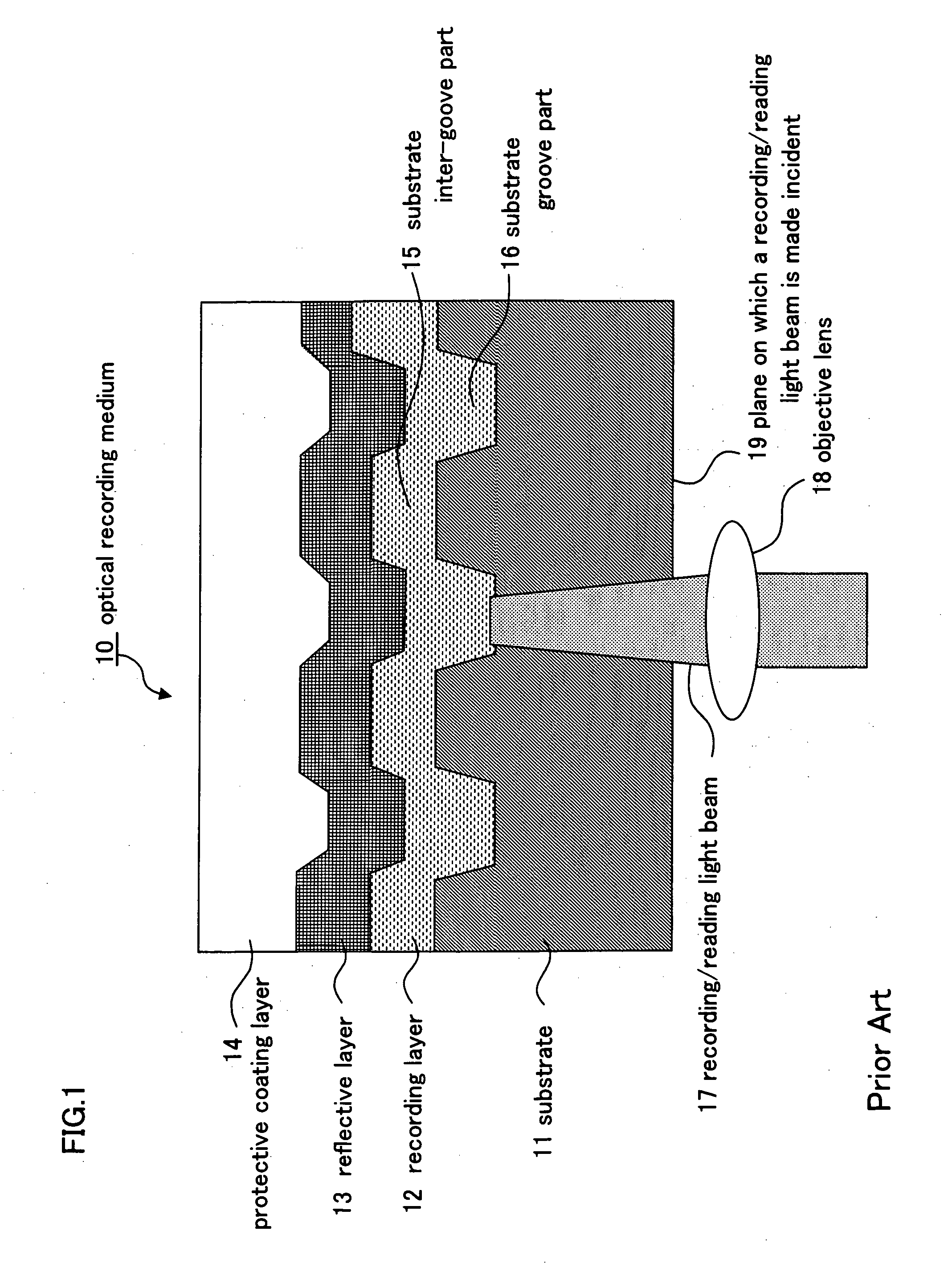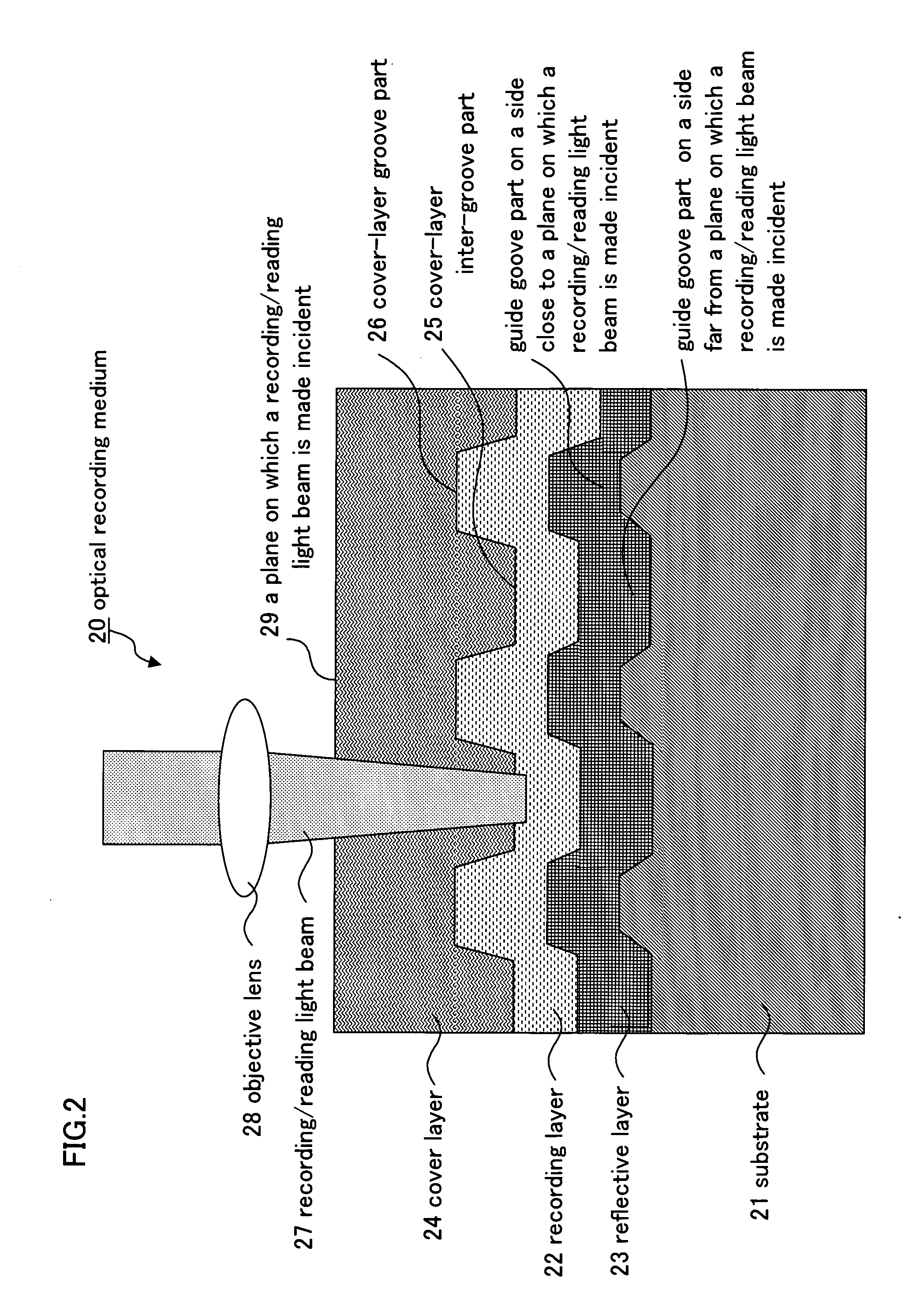Optical recording medium and optical recording method of the same
a technology of optical recording and optical recording, which is applied in the field of optical recording medium, can solve the problems of limited changes in reflectivity in a planar state, difficulty in achieving high modulation of 60% or more, and achieve good recording/reading characteristics
- Summary
- Abstract
- Description
- Claims
- Application Information
AI Technical Summary
Benefits of technology
Problems solved by technology
Method used
Image
Examples
example 1
[0375]FIG. 12 shows an absorption spectrum in a state where only the auriferous azo dye (dye A) used as the material of the recording layer was applied. Note that the chemical formula of the metal-azo dye (dye A) is represented below.
[0376] As is clear from FIG. 12, the metal-azo dye (dye A) has the main absorption band on the long wavelength side having the recording / reading light wavelength λ of 405 nm, and the peak thereof is around 510 nm. Thus, recording and reading were performed on the short wavelength side λs of the absorption spectrum.
[0377] The complex refractive index of the recording layer in the thin film in unrecorded state was nd=1.38 and kd=0.15. Moreover, in the recording layer after the solvent was dried and vaporized, dye A was regarded as 100% except for a very minute amount of residual solvent.
[0378] Assuming that the recording medium described above was disk 1, disks 2 and 3 were prepared, which had exactly the same configuration as that of the disk 1 excep...
example 2
[0396] In the configuration of the disk 2 in example 1, the following points were changed.
[0397] Specifically, as the material of the recording layer, a carbostyryl dye (dye B) (note that Ph was a phenyl group.) having the following structure and an metal-azo dye (dye C) were mixed at a ratio of 70:30 wt. %. Thereafter, by use of this mixture as a main component dye, 0.6 wt. % was mixed in octafluoropentanol, and coating was performed. Thus, the disk 4 having the same configuration as that of the disk 2 in the other conditions was prepared. dG was about 30 nm and dL was approximately 0.
[0398] In the recording layer after the solvent was dried and vaporized, mixture of carbostyryl dye (dye B) and the metal-azo dye (dye C) is regarded as 100% except for a very minute amount of residual solvent.
[0399]FIG. 16 shows an absorption spectrum in a state where only the carbostyryl dye (dye B) was coated. The complex refractive index of the recording layer was nd=2.18 and kd=0.34. The main...
example 3
[0403] Disk 5 was prepared from disk 2 in example 1. The disk 5 had the same configuration as that of disk 2 except that the thickness of the reflective layer was changed to about 15 nm. The disk 5 was prepared so as to become semi-transparent and to obtain transmittance of about 50% by setting the thickness of the reflective layer to 15 nm. Rg was about 7%. Also in this case, the main reflective surface is on any one of the interfaces of the reflective layer. Such a semi-transparent configuration can be applied to a multilayer recording medium. When the same examination as that in example 1 was performed, the signal amplitude was lowered. Moreover, the polarity of the push-pull signal was not changed. Thus, L to H recording by using the phase shift of 00 was performed.
[0404] For the disk 5, recording characteristics were also evaluated by recording and reading of a random signal as in the case of example 1. FIGS. 18 are graphs showing recording power dependence of jitter (FIG. 18A...
PUM
 Login to View More
Login to View More Abstract
Description
Claims
Application Information
 Login to View More
Login to View More - R&D
- Intellectual Property
- Life Sciences
- Materials
- Tech Scout
- Unparalleled Data Quality
- Higher Quality Content
- 60% Fewer Hallucinations
Browse by: Latest US Patents, China's latest patents, Technical Efficacy Thesaurus, Application Domain, Technology Topic, Popular Technical Reports.
© 2025 PatSnap. All rights reserved.Legal|Privacy policy|Modern Slavery Act Transparency Statement|Sitemap|About US| Contact US: help@patsnap.com



